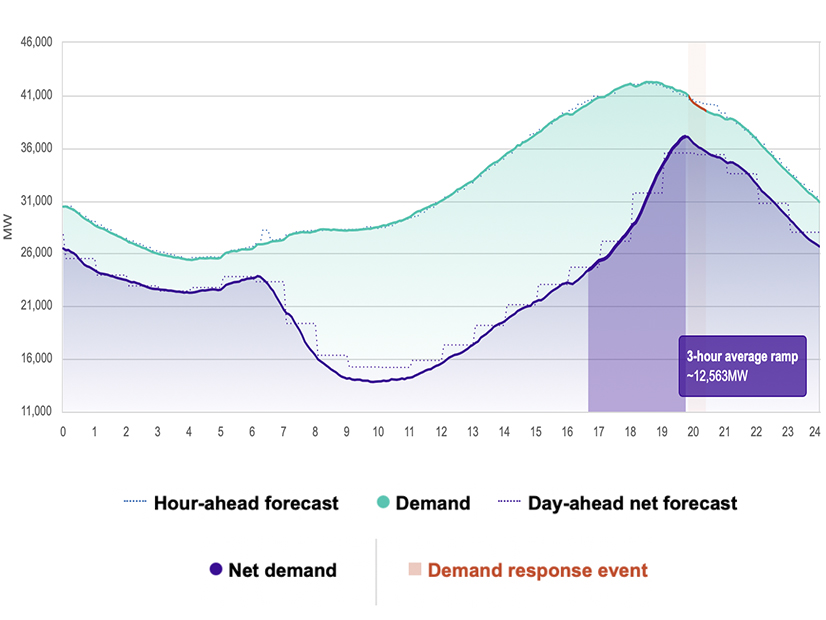
CAISO issued its first energy emergency alert (EEA) of the summer Thursday evening after coming up short on the ramping capacity needed to meet its peak net load as solar output rolled off its system during sunset.
The California grid operator declared an EEA-1 at 7:30 p.m. PT on a day marked by largely normal summer temperatures in most of the state’s population centers, as well as an elevated but relatively moderate system peak load of 42,266 MW, which occurred at 6:30 p.m. An EEA-1 represents the lowest level of grid emergency, called by the ISO when it confronts capacity shortages after all available resources either are in use or have been committed to use, prompting the need for conservation.
CAISO data shows that the ISO’s net load — total system load minus output from wind and solar — began to exceed the ISO’s day-ahead forecasts at about 6:40 p.m. By 7:50 p.m., as system load tapered to 40,989 MW, net load simultaneously rose to its daily peak of 37,038 MW, exceeding the day-ahead net load forecast of 35,533 MW for that five-minute interval.
“The market went into the hour a bit thin on the interchange while net demand was increasing,” CAISO spokesperson Anne Gonzales told RTO Insider. “The amount of energy available within the hour was not as robust during net load peak as solar ramped off the system, compared to other similar days. As a result, within the hour, the market was not moving enough resources to balance supply and demand while solar was ramping down.”
CAISO called on demand response resources beginning at the 7:50 p.m. interval, quickly reducing net load to levels closer to forecast. The EEA-1 was concluded at 8:30 p.m.
“As soon as the operators became aware of the situation, they manually dispatched additional generation, deployed some demand response programs available to them and made adjustments in the market to increase energy output and the EEA-1 was soon canceled,” Gonzales said.
The role of imports in the emergency remains an open question. While much of California saw moderate weather that day, neighboring areas in the Southwest continued to endure a record-setting heat wave accompanied by high electricity demand.
Asked whether “thin” conditions on the interchange indicated that imports into the ISO were lower than expected during the event, Gonzales said, “We’re still doing analysis on that. Demand came in slightly higher than forecast and more energy was needed for about an hour during the net peak load. We will know more after market analysis, however.”
Gonzales said the emergency would cause CAISO to make “adjustments going into the net peak hours to account for this going forward,” but added that it did not expect to issue a flex alert, EEA watch or call for restricted maintenance operations over the weekend.
Real-time prices during the event surged to around $250/MWh at nodes across the ISO, after hovering around $30/MWh and lower in the preceding intervals.
The EEA-1 occurred about a week after CAISO announced that this year it hit a 5,000-MW milestone for installed battery capacity, reaching 5,600 MW on July 1. California has moved aggressively to install additional batteries to help meet evening ramps, and the ISO expects to bring on an additional 2,000 MW in the next couple of months, CEO Elliot Mainzer said Wednesday during the joint meeting of the CAISO Board of Governors and Western Energy Imbalance Market’s Governing Body.
During that joint meeting, Mainzer also lauded the performance of CAISO and the wider West for managing challenging conditions in the face of widespread and persistent heat.
“Fortunately, notwithstanding a few local challenges, I think the overall grid has held up well, which I think points to certainly a lot of work within California and across the West on resource adequacy, bringing new resources onboard. Obviously outstanding hydro conditions inside California, and a tremendous amount of operational coordination and communication coordination around the region” also helped, Mainzer said.
“Of course, we have a lot of summer left. Ever vigilant, ever watchful,” he added.



